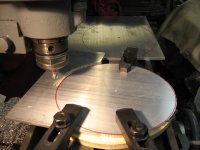APL
100 kW
- Joined
- Aug 6, 2018
- Messages
- 1,113
Also, I wanted to follow up on the anodizing process, in case anybody is planning to try it.
I tried boiling the parts in a weak mixture of Simple Green and distilled water for about 5 - 10 minutes, and
that worked like a charm. It's amazing how clean that SG will get aluminum!
Then I put it in the sodium phosphate for three hours on the 2 amp setting, which shows up as about one amp
on the charger meter. That changes with the size of the part. The part will have a yellow tint to it when it's
ready for the dye. The longer you leave it in the anodizing tank, the better it turns out.
Use distilled water for everything.
I imagine different kinds of aluminum will act differently to the process.
Now the problem is getting two pieces with a matching color. It would be wise to do all of the pieces at the
It would be wise to do all of the pieces at the
same time, through the system, if you wanted equal tints.
I bought 2 lbs of sodium phosphate on the bay for about $12. and used about three quarters of it. The solution
doesn't seem to degrade,.. or at least, hasn't yet.
I plan to do the rotors in a very light gold, and the bearing caps in red. Ooooh
Rotors are up next, at long last!
I tried boiling the parts in a weak mixture of Simple Green and distilled water for about 5 - 10 minutes, and
that worked like a charm. It's amazing how clean that SG will get aluminum!
Then I put it in the sodium phosphate for three hours on the 2 amp setting, which shows up as about one amp
on the charger meter. That changes with the size of the part. The part will have a yellow tint to it when it's
ready for the dye. The longer you leave it in the anodizing tank, the better it turns out.
Use distilled water for everything.
I imagine different kinds of aluminum will act differently to the process.
Now the problem is getting two pieces with a matching color.
same time, through the system, if you wanted equal tints.
I bought 2 lbs of sodium phosphate on the bay for about $12. and used about three quarters of it. The solution
doesn't seem to degrade,.. or at least, hasn't yet.
I plan to do the rotors in a very light gold, and the bearing caps in red. Ooooh
Rotors are up next, at long last!





